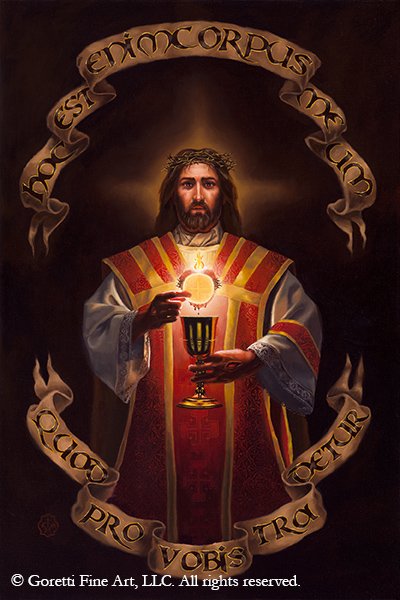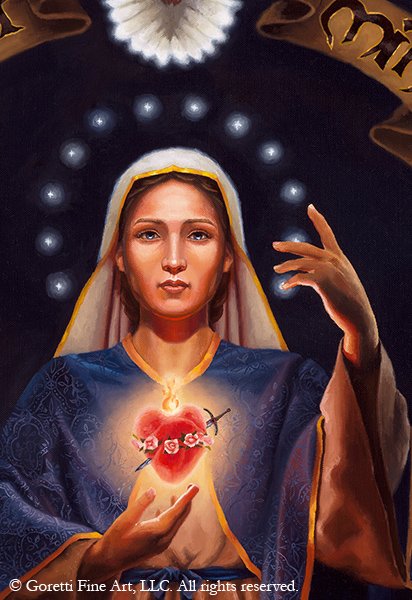Making of a Painting I: A Tale of Two Hearts
Having previously tackled the subject of the Sacred Heart of Jesus and the Immaculate Heart of Mary once before, George and I took the commission of two new paintings on this theme as an opportunity to have a fresh look at the representation of heavenly love. The patron, a Classical school, wanted depictions that were in line with its ideals: just as the institution dedicated itself to using time-honored techniques to lead students to the thrill of discovery, the paintings were to be steeped in the familiarity of tradition while at the same time possessing the power of the unexpected. The figures needed to be idealized yet accessible even to small children, and they had to convey the spiritual peace of holy stillness while captivating restless modern eyes.
Artistic Tradition
When taking on any project, we begin by thoroughly studying how a given subject has been represented throughout art history in order to understand how a new depiction could operate within the context of that tradition. In this case, we expanded our research beyond the Sacred and Immaculate Heart themes per se in order to see how the great masters of the past accomplished artistic goals similar to those we faced.
For example, we knew it was important for the pieces to feel classic (in the sense of conservative) and even Classical (in the sense of being influenced by the aesthetic of Greco-Roman antiquity), so as inspiration we looked at traditional icons as well as some Neoclassical works, aiming to emulate the compelling symmetry, powerful simplicity, and idealized facial structures that characterized these works. Our portrayal of Mary in particular was influenced by the wide cheekbones, long, delicate nose, and large eyes seen in Medieval (both Byzantine and Gothic) artistic traditions (e.g., Duccio’s Madonna and Child) and echoed in the output of the Academic painter Bouguereau.
Madonna and Child, by Duccio di Buoninsegna (ca. 1300)
Virgin of the Lilies, by William-Adolphe Bouguereau (1899)
Meanwhile, we decided to model the face of Christ after the Shroud of Turin, while maintaining a similar iconographic influence derived from the Christos Pantokrator motif. We wanted this influence to be seen both in the familiar facial structure as well as in the soul-piercing intensity of gaze.
Christos Pantokrator (6th c.)
Finally, we aimed to convey a supernatural presence and monumental dignity through a strong reliance on symmetry. The partially symmetrical poses of Christ and his mother on which we eventually settled are similar to those shown in Bouguereau’s Madonna above and in Ingres’ portrait of Napoleon below.
Napoleon I on His Imperial Throne, by Jean-Auguste-Dominique Ingres (1806)
Both figures in these 19th-century paintings dominate the composition not through ostentatious bravado but through calm, self-assured authority—something we hoped to capture in our portrayals.
The Creative Process
With these aims in mind, we decided to focus our compositions on the differing attributes of Christ’s and Mary’s love. As we honed our ideas, we arrived at the following compositional sketches, which we shared with the patron.
At this stage, the school committee suggested a few changes to the Immaculate Heart composition. They felt that, since Mary was directing her gaze upward, a connection with the viewer—and thus a critical element of parallelism—was missing when compared to the Sacred Heart drawing. The original purpose of the composition was to convey Mary’s complete abandonment of her being to God, but we knew we could stay true to that intention while incorporating their feedback. Working with the client is an essential step in the process of a commissioned work, and accordingly the composition was changed from the initial concept to the one seen in the completed painting.
In the final arrangement, Mary’s gaze is directed toward her earthly children, guiding them to her spouse, the Holy Spirit, through her upward gesture. She still offers her heart to God but invites the viewer into the embrace of her love more directly than before.
The patron liked the way that we portrayed Jesus as a priest and requested only limited adjustments to that drawing, but we still had our work cut out for us as we translated the grayscale arrangement into a compelling full-color rendition. Here, we emphasized Christ’s priestly sacrifice in the blood-red hue of his vestments and wounds. The greatest challenge was to integrate the complex lighting scheme in a way that was visually convincing. Just as at the Mass, Christ offers his body up for the viewer, with the glow emanating from his breast and passing through the semi-transparent wafer metaphorically merging the spiritual fire of divine love and the physical matter of the Eucharist.
Painting in Tandem
These pieces were commissioned as a pair, so it was important that they remained visually unified even as they emphasized different archetypes of heavenly love. To this end, we used the compositional components of the banners, the common brocade pattern, and the front-facing posture to provide key visual parallels. I also found it helpful to work on both canvases simultaneously in order to keep a consistent hand throughout (and to be able to use the same colors on identical elements without having to remix paint).
Beginning with a base of raw umber, I blocked in both paintings before spending a significant amount of time on the faces. With the portraits complete, the small details of the gold trim on the banners, the embroidered fabric, and the crowns of roses and thorns on the respective hearts were laid in to finish them off.
The resulting paintings are at once inviting and imposing. The crisp detail and strong contrast are best seen at a short distance and encourage the viewer to spend time in contemplation, making them perfect for the intimate setting of a small academic chapel. Our hope is that they will serve as reminders of the calm yet persistent presence of Christ’s and his mother’s personal love for each one of us—even amid the frenetic activity of a busy day at school!












